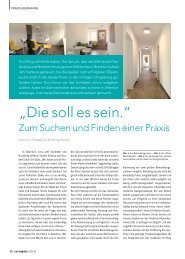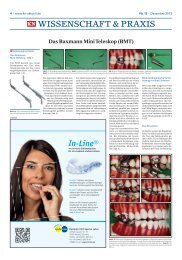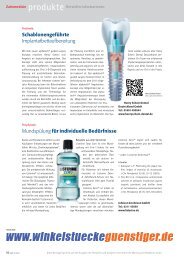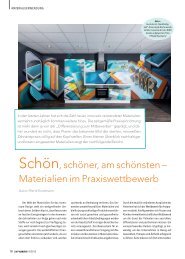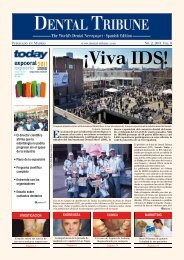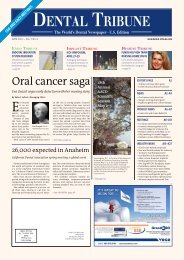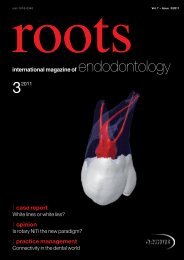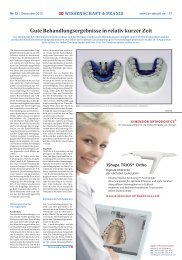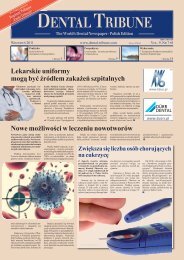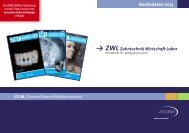Download - Oemus Media AG
Download - Oemus Media AG
Download - Oemus Media AG
You also want an ePaper? Increase the reach of your titles
YUMPU automatically turns print PDFs into web optimized ePapers that Google loves.
DeNtal tribuNe | april-June, 2010 Case report 7<br />
A case report: Unusual anatomy of maxillary second molar<br />
Dr P D Joshi<br />
India<br />
Introduction<br />
The main objectives of an<br />
endodontic treatment are the<br />
elimination of microorganism<br />
from the root canal system<br />
and prevention of subsequent<br />
reinfection of the system. 1 Inability<br />
to find and properly treat<br />
the canal may cause failure. 2<br />
This case report presents<br />
an unusual maxillary right<br />
second molar with four roots<br />
(mesiobuccal, distobuccal, mesiopalatal,<br />
and distopalatal). The<br />
unusual morphology of roots of<br />
the maxillary second molar<br />
may be a challenge in diagnosis<br />
and treatment execution. 3-5<br />
Diamond, in his textbook<br />
on dental anatomy, has shown<br />
two cases of maxillary first<br />
molars with two distinct palatal<br />
roots. 6<br />
Sabala, et al, in a radiographic<br />
survey, found that the most<br />
common aberration of maxillary<br />
molars involved the fusion of<br />
22 percent of the facial roots<br />
of second molars. 7 They discovered<br />
that aberrations occurred<br />
in less than 1 percent of the<br />
cases and that of 90 percent<br />
of such aberrations were bilateral.<br />
Libfeld and Rostein also<br />
examined 1200 teeth radiographically,<br />
and reported that<br />
four rooted maxillary second<br />
molars occurred in 0.416% of<br />
cases. 8 The four roots in maxillary<br />
molar is more frequent in<br />
second molars, the conclusion<br />
made by Christie, et al. 9<br />
This case report illustrates<br />
the importance of knowledge<br />
about unusual variations in<br />
morphology of root and canal,<br />
proper acess opening, gaining<br />
straight line access, proper<br />
cleaning and shaping of canals,<br />
and obturation.<br />
Case report<br />
A 34-year-old female reported<br />
to the clinic with the chief complaint<br />
of pain in relation to upper<br />
left back tooth region since two<br />
days, and pain usually occur<br />
after stimulation with hot and<br />
cold liquids. The patient gave the<br />
history of pain getting worse on<br />
lying down, and waking up<br />
with pain in the middle of the<br />
night. The clinical examination<br />
showed a large carious lesion<br />
on the buccal surface of the<br />
maxillary left second molar<br />
(#27). Vitality test with cold<br />
stimulant revealed severe, rapid,<br />
and long-lasting pain from<br />
maxillary left second molar.<br />
Pre-operative periapical radiograph<br />
revealed a large carious<br />
lesion on buccal surface of #27<br />
involving the pulp (Fig. 1). Based<br />
on clinical and radiographical<br />
evidence, it was diagnosed as<br />
irreversible pulpitis.<br />
The careful observation of<br />
periapical radiograph shows that<br />
the second molar has unusual<br />
root morphology, i.e., it has four<br />
separate roots. The unusual two<br />
separated palatal roots are long<br />
and diverging like horns.<br />
The non-surgical endodontic<br />
therapy was planned for tooth<br />
#27. The treatment was started<br />
with administration of local<br />
anesthesia using 2% lignocaine<br />
with 1:200000 adrenaline. Caries<br />
was removed, and then the<br />
missing buccal surface of the<br />
tooth was build up using glass<br />
ionomer cement fuji type II, to<br />
facilitate the isolation of tooth<br />
using Rubber Dam (Hygienic<br />
Corp., USA).<br />
A usual triangular access<br />
cavity (Fig. 2) was modified<br />
to square-shaped (rhomboidal)<br />
(Fig. 3) using cavity access set (by<br />
Dentsply Mail-lefer, Ballagues),<br />
and was further refined with tip<br />
#2 of Start X ultrasonic kit (by<br />
Dentsply Maillefer, Ballagues)<br />
(Fig. 4). After access opening,<br />
the four orifices were explored,<br />
namely mesiobuccal (MB), distobuccal<br />
(DB), mesiopalatal (MP),<br />
and distopalatal (DP). Two distinct<br />
palatal orifices related to<br />
two separate palatal roots were<br />
identified.<br />
The extensive search with<br />
Ultrasonic tip #2 of Start X<br />
was carried out for second<br />
MB, but could not be located.<br />
They were further straightlined<br />
with X-Gates of cavity access<br />
set (by Dentsply Maillefer, Ballagues)<br />
(Fig. 5 & 6). The working<br />
length (WL) was determined<br />
using Root ZX electronic apex<br />
locator (EAL), (by Dentaport ZX,<br />
J. Morita, Japan).<br />
Files were placed in the<br />
canals (Fig. 7) according to WL<br />
determined by EAL, and then<br />
one more periapical radiograph<br />
was taken to confirm the WL<br />
(Fig. 8).<br />
The cleaning and shaping<br />
of canals were carried out with<br />
rotary NiTi Protaper instruments<br />
series (by Dentsply Maillefer,<br />
Ballagues), according to<br />
the manufacturer’s instructions.<br />
The final instrumentation was<br />
carried out with sizes S1 to F3<br />
of NiTi Protoper instruments<br />
(Fig. 9). For irrigation, 3%<br />
sodium hypochlorite was used<br />
during instrumentation and as<br />
well as after completion of<br />
the preparation. Conefit was<br />
carried out with non-standardized<br />
gutta-percha of medium<br />
size (Sure-endo, Korea)<br />
with the help of gutta-percha<br />
gauge (Dentsply Maillefer,<br />
Ballagues) (Fig. 10 & 11).<br />
Now, the canals were dried<br />
using paperpoints of size F3 (by<br />
Dentsply Maillefer, Balla-gues)<br />
and then obturated with selected<br />
cone, using down pack with system<br />
B and back pack with obtura<br />
II device (Fig. 12). A periapical<br />
radiograph (Fig. 13) was taken<br />
to confirm the quality of obturation.<br />
Permanent restoration was<br />
done on the next appointment.<br />
Discussion<br />
Incidence of four rooted maxillary<br />
second molar is very rare.<br />
Etienne Deveaux 10 presented<br />
a case report in Vol. 25, No. 8,<br />
JOE Aug. 1999, and Peter M<br />
Di Fiore 11 presented first molar<br />
in Vol. 25, No. 10, JOE Oct. 1999.<br />
Hartwell and Bellizi 12 reported<br />
that 9.6% of maxillary molars,<br />
they examined, had four canals,<br />
but had not mentioned about<br />
any case with four roots.<br />
Christie, et al, 9 have proposed<br />
a classification system for four<br />
rooted maxillary second molar<br />
abnormalities.<br />
Fig. 1: Pre-operative radiograph Fig. 2: Triangular access opening Fig. 3: Modified (Rhomboidal) access opening Fig. 4: Ultrasonic Tip<br />
Fig. 5: X-Gates being used for straight lining of access Fig. 6: Access after orifice enlargement Fig. 7: Files in position for WL Fig. 8: WL radiograph<br />
Fig. 9: WL radiograph for buccal canals Fig. 10: Shaping with Protaper Instruments Fig. 11: Conefit Fig. 12: Conefit Radiograph



